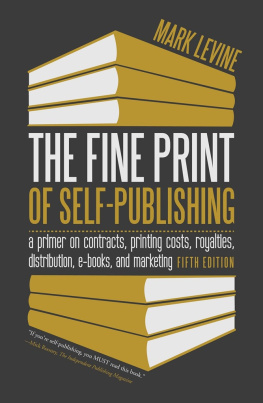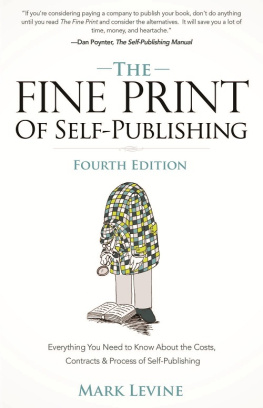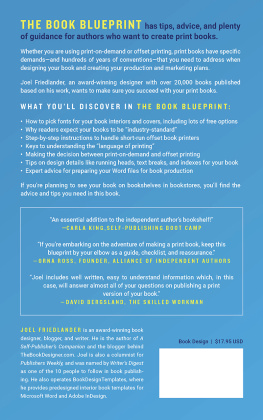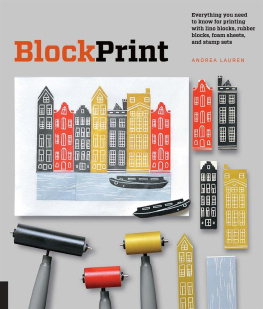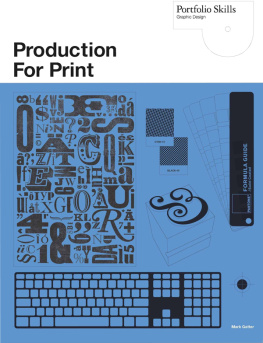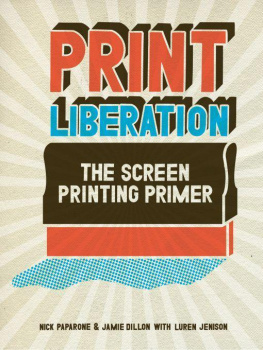All rights reserved. No part of this publication may be reproduced, stored in a retrieval system, or transmitted, in any form or by any means, electronic, mechanical, photocopying, recording, or otherwise, without the prior written permission of the author.
This book is dedicated to all the writers who know there is a book inside of them. One of the most amazing publishing experiences you can have is to hold a printed and bound copy of your own book for the first time. I hope The Fine Print of Self-Publishing helps you find the right publisher for your book.
INTRODUCTION
If youve been considering self-publishing for any length of time, your head probably feels like its about to explode. Between the books, the blogs, the publishing-related websites, and the opinions of writers, friends, enemies, frenemies, true publishing professionals, and people who hold themselves out as publishing gurus or divas, you may just want to throw your arms up in the air and scream.
The publishing world, as you probably know, is changing so rapidly its hard to keep up. Throw in which retailers are picking whose sides, and youve got the makings of a reality show that would put a Real Housewives cast to shame. And, just for fun, toss in the multibillion-dollar world of e-book publishing (which has exploded since the last edition of this book was published), and, well, its about as interesting as it gets.
There are the headline-grabbing changes, and then there are the ones that affect the writers trying to get their books published. If you are reading this book, you probably already know that its harder than ever to get published traditionally. One fiction editor estimated that only 1 in 100 novels get published by a traditional publisher. This means that more authors are competing for fewer spots on a publishers roster.
You should look at statistics like these as blessings in disguise. They force writers to abandon the notion that nabbing a contract from a traditional publisher is some kind of Holy Grail. For writers lucky enough to get such a contract, the reality is that many traditional publishers, especially smaller ones, have small or even nonexistent marketing budgets for books by new authors. Many of these publishers make the expenses of book marketing the responsibility of the author, who gets a minuscule royalty from each sale. In most of these cases, if a title by a new author is successful, it is due to the authors efforts.
Of course, you have to balance that with the fact that the publisher, big or small, took the risk of all of the upfront production costs. In the event that the book is successful, the traditional publisher gets the lions share of the reward, even though the author may have spent a lot of time and money marketing the book. Fair? Depends on how much risk the author wants to take. Since traditional publishing contracts are harder to get these days, only the author who secures a publishing deal will have the opportunity to weigh such options.
While its great to be a dreamer, in book publishing its smarter to be a realist. One of the best reports chronicling the reality of book sales was done in 2004 by Nielsen BookScan, which tracked the sales of 1,200,000 books through retail locations (including online retailers) in the United States. Of all books sold, 79 percent sold less than ninety-nine copies. Remember, these figures are almost a decade old, so when you factor in the explosive growth of self-published titles since 2004, the percentage of books selling fewer than 1,000 copies would be greater still.
If youre serious about publishing your book, self-publishing (either on your own or through a good self-publishing company) might be your only optionand your best one, even if a traditional publisher is interested. The biggest growth area in book publishing is in self-publishing. The number of self-published print titles in the US alone has exploded by 287 percent since 2006.
Yes, the marketplace is more crowded than ever before. But the opportunities to distribute and market your book have also expanded like never before. The Internet has helped to level the playing field, but it takes more than having a website and a Facebook account to be successful online. There are many facets to effective book marketing, both on- and offline. Chapter 7 touches on several of them, but believe me: online book marketing could fill a book by itself.
If you want proof that online marketing works, youre reading it right now. When I published the first edition of The Fine Print of Self-Publishing in 2004, I couldnt afford any traditional book publicity efforts, such as hiring a publicist to get me on radio programs, or buying ads in relevant print publications, like Writers Digest . So, I marketed this book exclusively online. Ive still never purchased an ad in a magazine, on the radio, or on television. The website for this book is search engine optimized (SEO) and ranks high on search engines for terms that I know authors use when looking for information on self-publishing over the Internet. I also purchase pay-per-click ads on most major search engines, which helps put my book in front of people who are already searching online for information about book publishing.
Combining smart online marketing with an e-book-only release can take your publication to a whole new level. By cutting out the costs of a printed book, the postage fees, and the customers wait for delivery, you ensure a nirvanic book experience can be enjoyed by all (with the exception of those who prefer the smell and feel of a physical book).
This isnt to say that printed books are going away. They arent. But the advances in e-book reading technology and continued price reductions in e-book readers and tablets make e-books a must for almost every author. In the first quarter of 2012, e-book sales (based on data from 1,189 publishers) surpassed hardcover book sales at $282.2 million (compared to $229.6 million for hardcover books).
As e-readers move down in price and consumers become more comfortable curling up with a device instead of with a print book, e-book sales will grow even faster. The Book Industry Study Groups November 2012 report, Consumer Attitudes Toward E-Book Reading , revealed how and why American book buyers are turning toward e-books. Sixty percent of people who purchased an e-book over the eighteen months of the study exclusively bought books in e-book format. In the last edition of this book, I said there was an e-book revolution happening. Its no longer a revolution, it just is. Thats why youll find an entire section of this book (chapter 6) dedicated to e-book publishing.
As the publishing world evolves, authors like you and me have more opportunity than ever before to carve out our slice of the publishing pie without waiting for traditional publishers to open the door for us. What makes The Fine Print unique among books on self-publishing is that Ive experienced the industry as an author, a book publisher, and a marketer. I know what it feels like to hold a copy of my own finished book for the first time. I also know what it takes to publish, print, and market that book. In addition to this publication (and its four previous versions), Ive published two of my own novels. Ive made every mistake you can make in publishing and have tried just about every type of marketing tool available.

